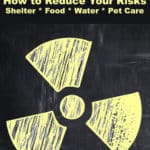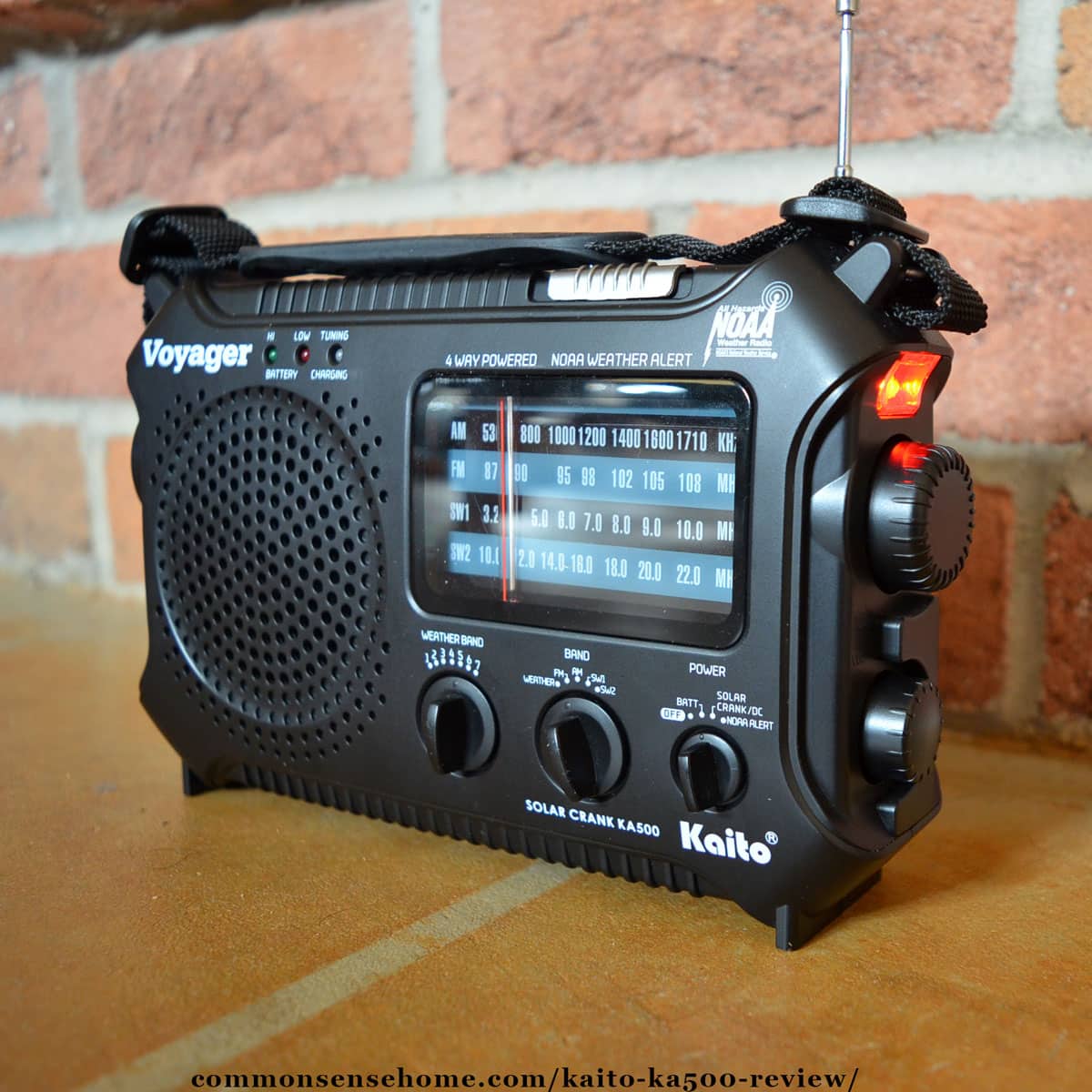Nuclear Radiation Exposure – How to Reduce Your Risks
This post may contain affiliate links. Read my full disclosure here.
This post focuses on potential low dose nuclear radiation exposure. We address the risks of radiation in homes, food and homesteads. We’ll discuss the most common radiation concerns, and steps you can take to deal with them.
Many people have concerns about Putin putting Russian nuclear deterrent forces on high alert. China is also threatening Taiwan, and creating supersonic low earth orbit missiles that could deliver nuclear weapons. There are also threats of dirty bombs or other terrorist activities.
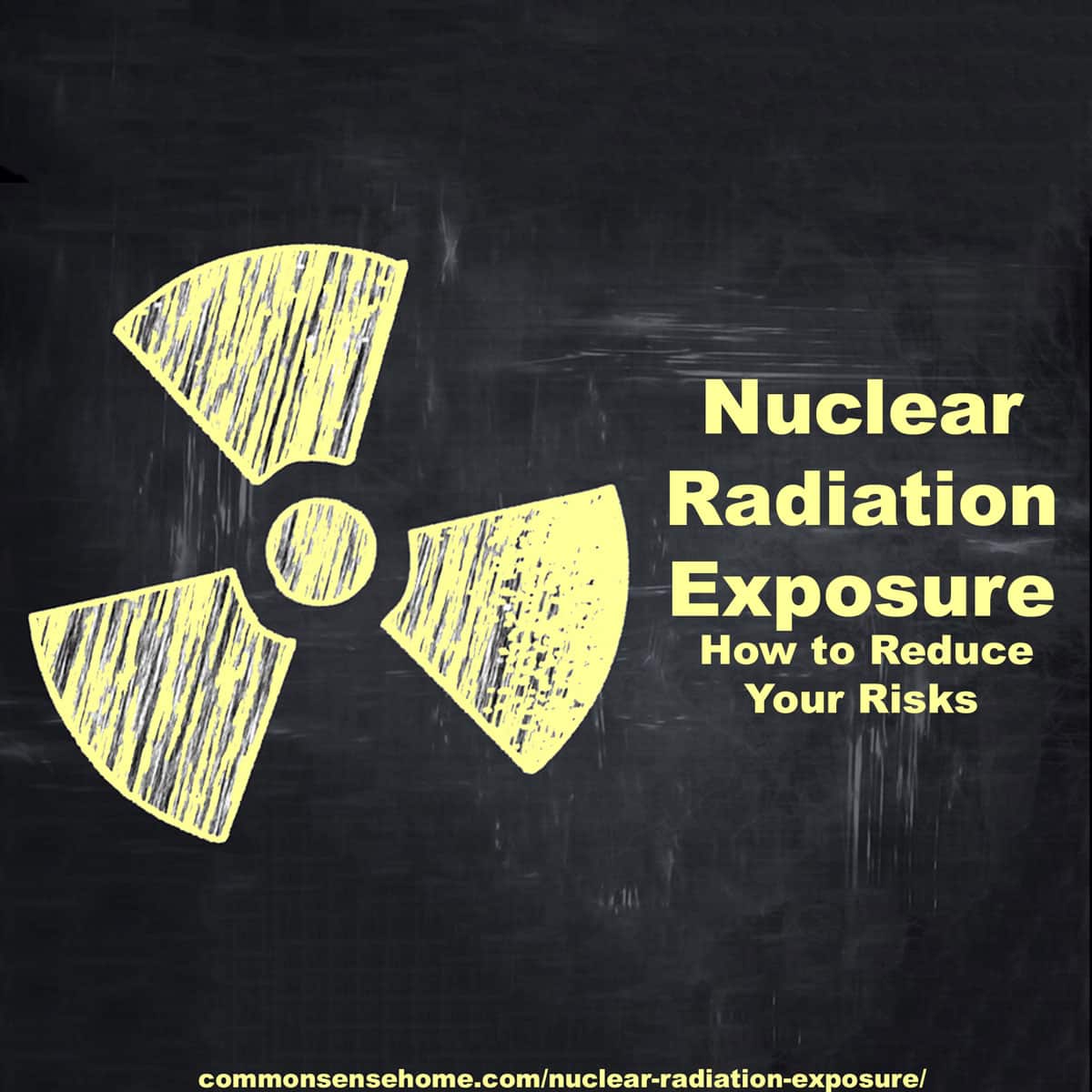
Table of contents
- What can I do to reduce radiation exposure?
- Foods that may help with Radiation Exposure
- Miso
- Iodine Rich Foods
- Spirulina
- Chlorella
- Cruciferous Vegetables
- Whole Grains
- Other Spices and Herbs
- Mushrooms
- What about radiation in the water supply?
- Topical Treatment for Radiation Exposure
- What if there is Radiation in the Food?
- My livestock or crops have radiation exposure. What can I do to protect them, and is the food from them safe to eat?
- Preparing in Advance
- Frequently Asked Questions
- Related Articles
What can I do to reduce radiation exposure?
Immediately following a nuclear explosion there a number of steps to take.
- Get inside. Shelter in the nearest building to avoid radiation. Brick or concrete are best. This is important because it reduces your exposure to irradiated dust and particles.
- Clean up. If you were outside when the bomb went off, remove contaminated clothing and wipe off or wash unprotected skin. Leave the contaminated clothes in a “mud room” or cleanup space. Do not bring clothes inside.
- Shelter. If the bomb is close, go to the basement or middle of the building. Stay away from outside walls.
- Stay Inside.
- Roughly seal windows and doors to reduce dust/debris getting into your home/shelter. Close drapes, cover windows.
- Move water and dry food near the center of the building or basement.
- Go to the basement or middle of the building.
- Dose up with Potassium Iodine per instructions
- Wait 24 to 72 hours. Stay inside for 24 hours unless local authorities provide other instructions. We recommend staying inside longer. The more exotic radioactive materials will degrade very quickly, so radiation exposure will drop roughly 1/2 each day (varying widely) which is why a Geiger Counter is valuable.
If you are exposed…
If you are exposed to to high dose radiation, seek help from a trained health care provider if possible. High level exposure has a number of negative health effects, including skin burns, acute radiation syndrome, increased risk of cancer and cardiovascular disease, and other health problems.
Most people will not die immediately in a nuclear attack (see below).
Radiation exposure increases cancer risk, but there are steps you can take to help your body repair the damage. It’s generally not the radiation itself, but the radioactive particles that stick around for a while. You can take steps to reduce your radiation exposure over time, as we explain below.
How Fast Does Radiation Decrease?
Radiation levels decrease rapidly. For every seven-fold increase in time after detonation, there is a tenfold decrease in the radiation rate.
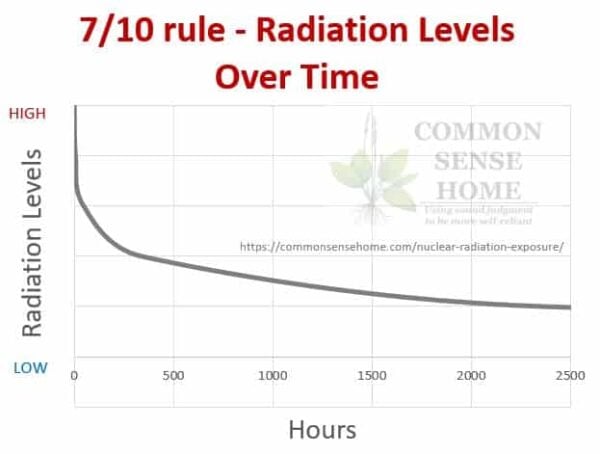
Note that this graph represents a lab decrease. If you have more fallout or are near radioactive debris the curve will be flatter or the early part may persist slightly longer. This is why you should stay inside at least 3 days, during the worst radiation levels.
Data Source: Radiation Risk Information for Responders Following a Nuclear Detonation
Foods that may help with Radiation Exposure
In his book Macrobiotic Diet, Michio Kushi states: ‘At the time of the atomic bombing of Nagasaki in 1945, Tatsuichiro Akizuki, M.D., was director of the Department of Internal Medicine at St. Francis Hospital in Nagasaki.
Most patients in the hospital, located one mile from the center of the blast, survived the initial effects of the bomb, but soon after came down with symptoms of radiation sickness from the radioactivity that had been released.
Dr. Akizuki fed his staff and patients a strict macrobiotic diet of brown rice, miso* and tamari soy sauce soup, wakame and other sea vegetables , Hokkaido pumpkin, and sea salt and prohibited the consumption of sugar and sweets. As a result, he saved everyone in his hospital, while many other survivors in the city perished from radiation sickness.’”
Real foods have the power to heal, and they can help protect and cleanse the system.
The majority of Americans are iodine deficient, so we should be taking steps to add iodine rich food sources to our diets regardless of potential radiation exposure. I remember reading years ago about how miso soup and sea vegetables were used in the aftermath of the bombing of Nagasaki to treat radiation sickness.
Foods that help your body to detoxify from radiation exposure include:
Miso
From “Natural Ways to Combat Radiation Poisoning: “Miso broth is the classic food for prevention of radiation damage. There’s twice the protection if a quarter-ounce/5 grams of dried kelp seaweed is added to the soup.
In scientific studies, seaweed was able to neutralize radioactive isotopes in the human body. Researchers at McGill University say radioactive strontium binds to the algin in brown seaweeds to create sodium alginate, a compound easily and harmlessly excreted.”
Iodine Rich Foods
Seaweeds, such as wakame, dulsi, kelp, kombu, hijiki, etc. can protect your tissues by keeping radioactive iodine out.
Spirulina
See “5 Grams Daily of Spirulina REVERSED Severe Radiation Poisoning in Chernobyl Children” Get Spirulina online here.
Chlorella
Studies suggest that chlorella taken orally may reduce radioactive particles accumulating in body tissues.
Cruciferous Vegetables
These are cabbage family plants such as broccoli, cabbage and mustard greens. The sulfur compounds in these vegetables trigger increase expression of your glutathione system, helping to detoxify heavy metals and bind free radicals.
Whole Grains
Whole grains bind minerals (including radioactive ones) and transport them out of the body.
Other Spices and Herbs
Tulsi (holy basil), cilantro, turmeric, ginkgo biloba, and aloe vera have also been used to treat radiation exposure
Mushrooms
In the article “Could Consuming This Mushroom Protect Against Radiation?”, Alexandra Preston notes fungi thriving in heavily irradiated areas. (Mycoremediation uses mushrooms to clean up toxic waste and radiation.)
She sites studies that indicate that indicate high melanin varieties of mushrooms may provide radiation protection. Some mushroom varieties are also high in selenium, which is also protective.
Selenium protects DNA from radiation damage and helps prevent damage to the skin surface, too. Get plenty of selenium by eating a daily dose of 2 cups/500 ml of nettle infusion, one-half ounce/15 g kelp, 2 ounces/60 g cooked burdock root, or 1 cup/250 ml organic yogurt daily.
Shellfish, green and black teas, and garlic contain significant amounts of selenium, as do many mushrooms. The best sources however are nettles (2200 mcg per 100 grams), kelp (1700 mcg/100 g), burdock (1400 mcg/100 g), catnip (Nepeta cataria), ginseng, Siberian ginseng, and astragalus.
What about radiation in the water supply?
Water storage is critical. In the event of an emergency, it is common for water supplies to be disrupted.
At a minimum, you should store one gallon of water per person per day. The minimum is to plan for at least 3-7 days. Several gallons per day per person would be better.
See “Emergency Water Storage and Filtration – What You Need to Know” for more information on water storage.
Radiation is in the particulates, not the water itself. So the better the filter the more particulates you remove, the lower the radiation exposure you will have. NOTE: The filters will be radioactive, so get them out of living spaces as soon as possible (far away).
To get radiation out of your water, look for a high quality filter such as reverse osmosis (RO) system or Berkey Filter. RO systems are commonly built into home water supplies.
Berkey filters are gravity driven – fill the reservoir and wait for it filter. Berkey did radiation filtering testing on their black Berkey filters. They found that they reduced both alpha and beta radiation contaminants and uranium by over 95%, meeting all EPA requirements for drinking water. See radiation filtering test results.
Buy a Big Berkey Water Filter online here.
Topical Treatment for Radiation Exposure
Simple home remedies for external use can help to pull toxins from the body. Baking soda baths and Epsom salt baths will help draw toxins out of your skin.
The burn aspect of radiation may be treated similarly to sunburn, with the application of aloe or other soothing creams. See Home Remedies for Sunburn for more treatment suggestions.
Again – Please see a trained healthcare professional in the case of significant radiation exposure. This post is for informational purposes only an is not meant to replace the care of a trained healthcare provider.
What if there is Radiation in the Food?
The Centre for Food Safety of Hong Kong discusses Food Safety and Radiation Exposure:
Reduce surface radioactive contamination on food by washing, brushing, scrubbing, or peeling. It is also possible to store contaminated food for prolonged times to allow radioactive decay of short-lived radionuclides.
…Cooking in general cannot reduce the level of radioactive contamination in food.
You can wash off surface contamination, but there’s no practical way to remove contamination from deep in the tissues. Avoid consuming contaminated food if possible.
My livestock or crops have radiation exposure. What can I do to protect them, and is the food from them safe to eat?
For food crops: If crops are exposed to only small amounts of radiation, chances are that they are safe to eat. Wash, scrub, peel or shell produce to remove surface radiation.
Soak the produce in some water with baking soda and sea salt mixed for additional protection. (If it works for detoxing people, why not produce?)
If it is weeks or months until harvest, much of the radiation will break down naturally. Many common radioactive particles have short half lives. (This advice is for low levels of exposure that do not visibly damage crops.)
For livestock and pets: Keep animals under cover, in the house or a barn interior if possible during times of radiation exposure. Tied them toward the center of the building, and keep their food covered.
Would you like to save this?
For food piles outside and exposed to radioactive fallout, remove the surface layer of foodstuffs and feed material from underneath. If there is warning, throwing a tarp over exposed animal feed will help. Supplement the animals with some of the same food materials recommended for human detoxification, such as sea vegetables.
For more detailed recommendations on dealing with radiation exposure to food crops, please see:
- RADIOLOGICAL EMERGENCY INFORMATION FOR FARMERS, FOOD PROCESSORS AND DISTRIBUTORS from the Massachusetts Department of Public Health
Preparing in Advance
There are a couple things you can get to prepare. Tarps, water storage, duct tape, potassium iodine and a radiation detector (Geiger counter).
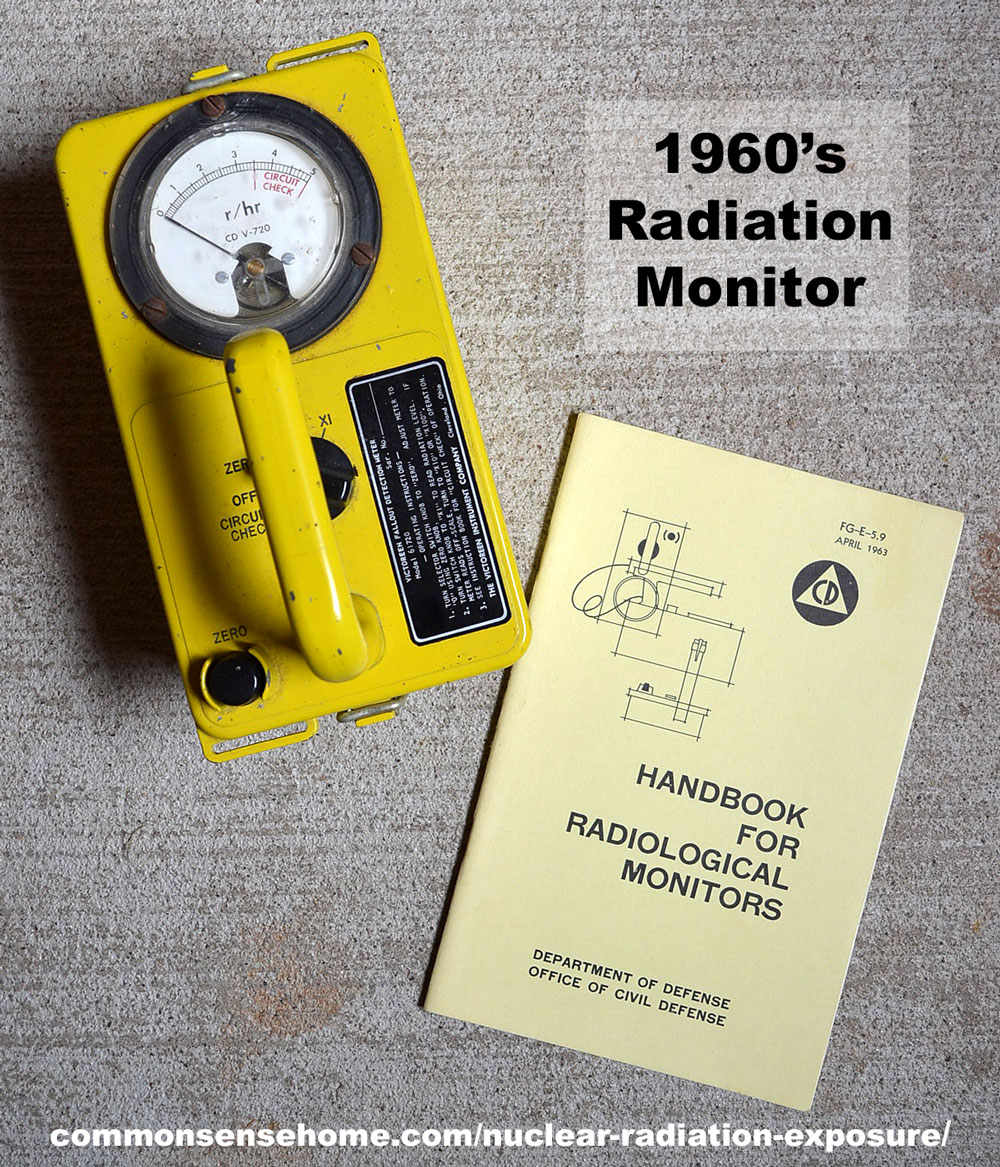
Radiation Detector
Radiation detectors (also known as a Geiger counters or dosimeters) measure radiation. You can purchase radiation detectors online through a number of vendors.
There are companies that offer calibration services for the old school “civil defense” Geiger counter like the one my dad gave me. The old school ones are less likely to be damaged by an EMP.
You can detect the level of radiation in an environment if you purchase a Geiger counter such as the GQ GMC300EPlus or RAD Triage single use “card”.
If you want to carry one all the time, here is a keychain Geiger counter that will last about 10 years.
We have two of the GQ GMC units and they are simple, rechargeable and easy to use. Store these in a faraday bag or faraday cage, because a nuclear bomb likely will destroy electronics (anything with a computer chip) and most things that run on electricity.
Potassium Iodine
Potassium Iodide pills are only one of dozens of ways to help your body cope with radiation exposure.
As a stable salt of iodine, potassium iodide helps block radioactive iodine from being absorbed by the thyroid gland.
Please be aware that potassium iodide does have side effects and can interact with other medications.
Frequently Asked Questions
What is Radiation?
Here’s a brief explanation of radiation from the Health Physics Society:
Radiation is energy that comes from a source and travels through space and may be able to penetrate various materials. Light, radio, and microwaves are types of radiation that are called nonionizing.
The kind of radiation discussed in this document is called ionizing radiation because it can produce charged particles (ions) in matter.
Ionizing radiation is produced by unstable atoms. Unstable atoms differ from stable atoms because unstable atoms have an excess of energy or mass or both. Radiation can also be produced by high-voltage devices (e.g., x-ray machines).
Unstable atoms are said to be radioactive. In order to reach stability, these atoms give off, or emit, the excess energy or mass. These emissions are called radiation.
The kinds of radiation are electromagnetic (like light) and particulate (i.e., mass given off with the energy of motion).
Gamma radiation and x rays are examples of electromagnetic radiation. Gamma radiation originates in the nucleus while x rays come from the electronic part of the atom. Beta and alpha radiation are examples of particulate radiation.
Interestingly, there is a “background” of natural radiation everywhere in our environment. It comes from space (i.e., cosmic rays) and from naturally occurring radioactive materials contained in the earth and in living things.
The document from the Massachusetts Department of Public Health states: “A sheet of paper stops alpha particle. A thin sheet of metal stops beta particles. Concrete or lead stops gamma rays, which are the most penetrating.”
This is yet another reason I’m thankful to live in a house built with Insulated Concrete Forms.
Will all Nuclear Bombs Create Fallout and Radiation?
No. Some only create an fallout and an EMP, some only an EMP, and some only fallout. Fallout is dust and debris sucked into the mushroom cloud and irradiated.
Not all nuclear explosions create a mushroom cloud or radioactive dust/debris. An example is a High Altitude Nuclear Explosion (HANE), which results in a large EMP (Electro Magnetic Pulse) but very little to effectively no nuclear fallout.
The EMP is dangerous also, but for different reasons. For more information, see “Electromagnetic Pulse (EMP) – What You Need to Know“.
Warnings About Nuclear Radiation Exposure
In the event of a nuclear radiation emergency, most areas have some method of warning the effected populations. These include automated calling systems, warning sirens or announcements on TV or radio.
Include an emergency radio in your emergency preparedness kit so you receive announcements even during power outages.
Would we all die in a nuclear war?
Assuming you would die in a nuclear attack is not entirely accurate.
A 1,000-kiloton (1 megaton) nuclear blast could produce third-degree burns up to 5 miles away, second-degree burns up to 6 miles away, and first-degree burns up to 7 miles away (these distances can vary some). Some people up to 50 miles away could also experience temporary blindness based on prior nuclear bomb testing.
Nuclear warheads vary from 600 kilotons to 2200 kilotons, with a few rare larger exceptions. The Russians created a 50 megaton warhead, but most of the Russian missiles are 800 kiloton warheads.
If you are 60 miles to 100 miles from a target, you are unlike to die immediately, BUT you might get nuclear fallout. Follow the rules and you survive without a lethal radiation dose.
How much damage does a nuke actually do?
Known warheads from US/Russia/China vary from 600 kilotons (roughly 10-12mile radius) to 2200kilotons or 2.2mt (roughly 17 mile radius). Note: The Russians did create a 50 megaton warhead but that was a one off that we know of.
Most of the Russian missiles are 800 kiloton warheads (12-13mile radius – think a circle 24 to 26 miles across). That means a 10mile radius for a small nuke to 20mile radius for a big nuke.
All the serious damage is in the first 1/3rd of the radius. So small nukes destroy a 4mile radius and a big one destroys a 7 mile radius for the “destruction zone”. Everything else in the radius still gets damaged, but stuff in that smaller area is basically gone.
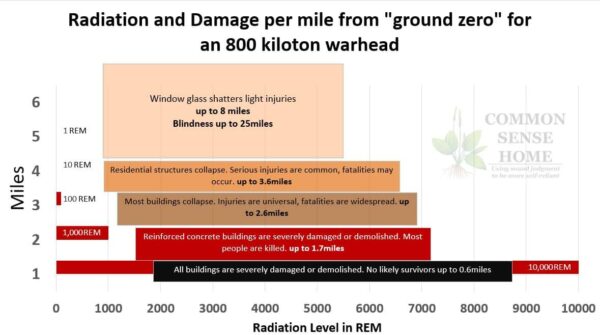
The damage ranges are bigger for a 2200 kiloton detonation but note that the radiation is not really different.
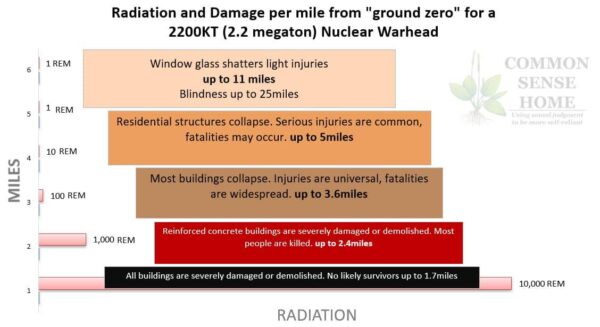
2200KT (2.2 megaton) Nuclear Warhead
Now that said, being out of range, but down wind of ANY of these will SUCK for 72 hours to 7 days, depending on weather altitude of detonation, debris etc.
Small nukes may be a bigger wind problem because if they are surface detonation they could irradiate more particles and make the half life curve spread out downwind.
The immediate affect of a nuclear explosion decreases quickly with distance. The farther you are away the better for the explosion. For each doubling of distance from a source of gamma and other radiation you will reduce your exposure by factor of four. Distance helps but remember being down wind is still a problem.
Regardless of the scenario, it is BAD DAY if these go off ANYWHERE.
What about the risk of terrorist attack using nuclear weapons or dirty bombs?
It’s an unfortunate fact that there are people out there who want to purposely hurt others. Risk of terrorist attacks are greatest in larger cities and coastal areas, due to the impact of devastating large numbers of people at one time and the accessibility of ports. If a weapon is detonated in a ship off the coast, it can still irradiate a significant portion of the coastline.
This study discusses the risks of radiation based terrorist attacks, and what to do about them:
“A Risk and Economic Analysis of Dirty Bomb Attacks on the Ports of Los Angeles and Long Beach“
Hopefully you’ll never need this information, but we figure it’s better to have it and not need it than need it and not have it.
More info from the feds: Nuclear Explosion Information at Ready.gov
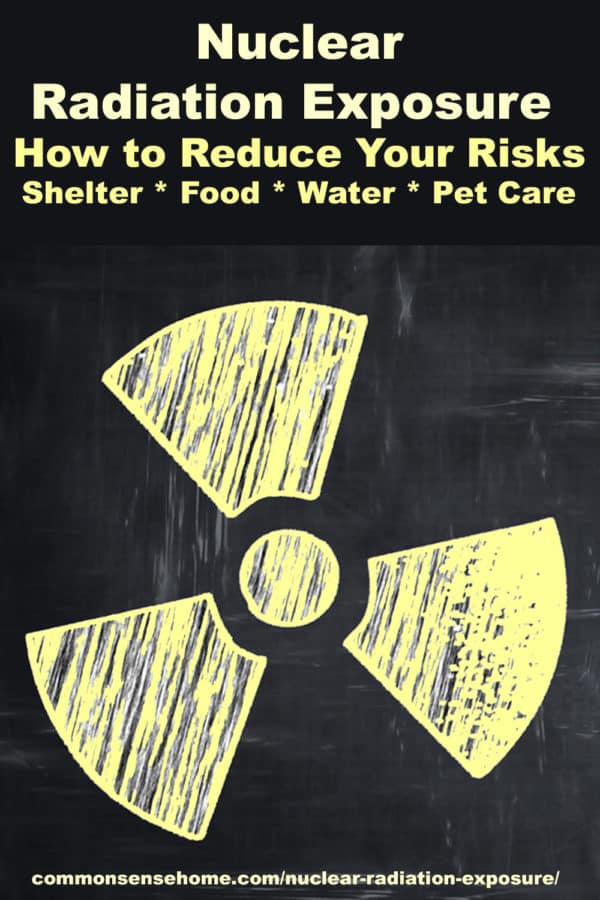
Related Articles

This post was written by August Neverman IV. August has a strong background in emergency preparedness. He served on several emergency preparedness teams during his tenure at Brown County WI Government, the Medical College of Wisconsin, HSHS, a 13-hospital system and emergency response training during his time with the Air Force and Air National Guard. Learn more about August.

